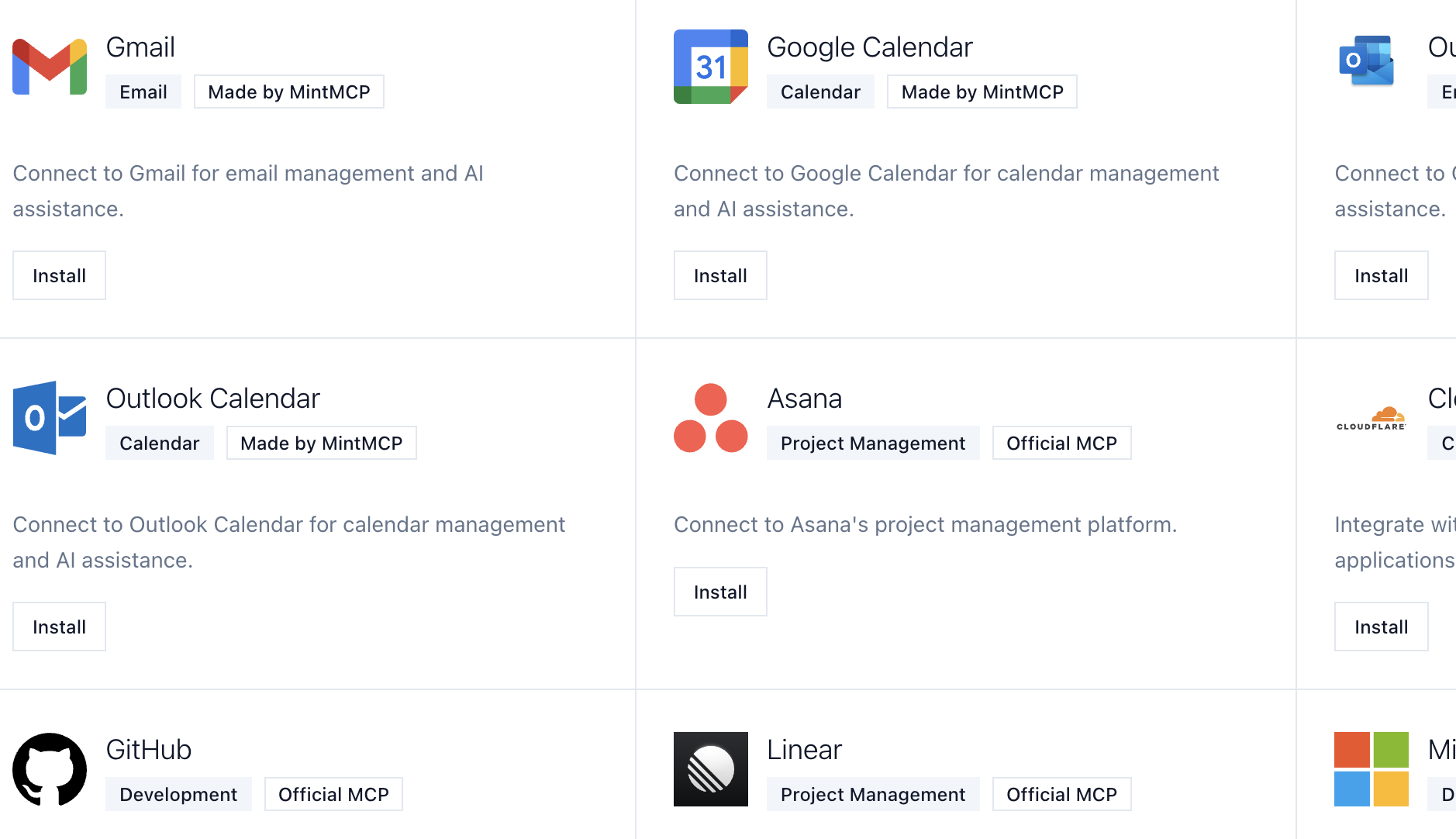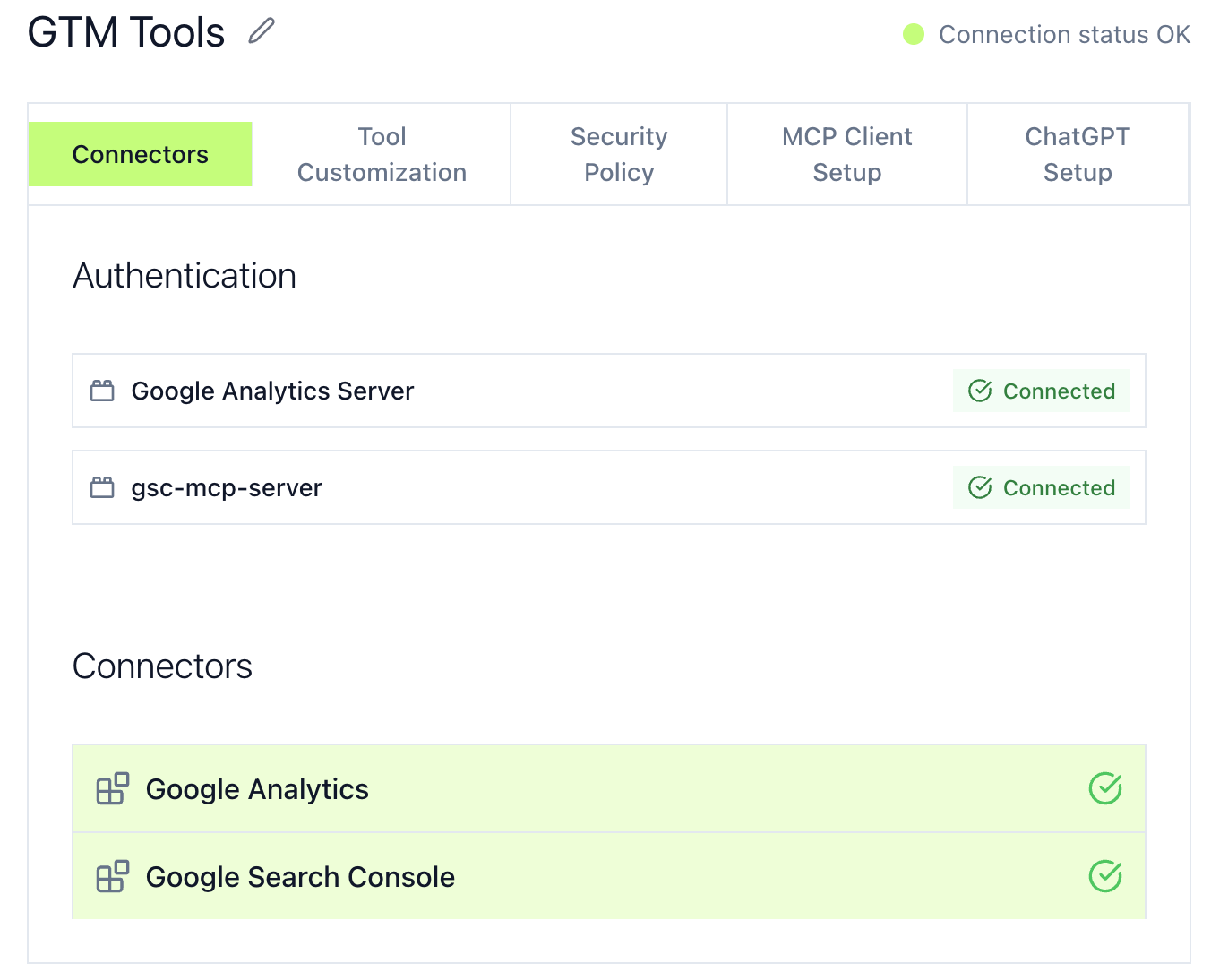Packaging VMCPs for Teams and Use Cases
Virtual MCPs enable a fundamentally different approach to MCP deployment. Instead of users installing multiple MCP servers individually, administrators package related MCPs into team-specific bundles.
The Challenge
Individual MCP servers require users to install and configure each separately, manage credentials per service, and keep servers updated independently. A marketing team needs Google Search Console MCP, Google Analytics MCP, and potentially other tools—each with separate setup and maintenance.
How Virtual MCPs Solve This
Administrators package multiple MCP servers into one endpoint for specific teams. A "Marketing Analytics VMCP" combines Google Search Console and GA4 MCPs, providing SEO and web analytics through a single URL with centralized authentication and governance. Users configure one VMCP instead of multiple servers.
This packaging approach is new to MCP server deployment—most users manage servers individually. Virtual MCPs shift this to centralized team-focused bundles.
Value: Centralized Control
Deployment
- Users configure one VMCP URL instead of multiple servers
- Updates propagate automatically to all users
Governance
- Manage permissions at the VMCP level
- Centralized audit trails across all packaged MCPs
Operations
- Store credentials centrally, not on user machines
- Track usage and costs across the entire tool bundle
Real-World Examples
Marketing Analytics VMCP
Combines Google Search Console + Google Analytics 4 for marketing teams:
Tools included:
search_analytics- Search performance data with Quick Wins detectionrunReport- Custom analytics queries with dimensions and metricsgetPageViews,getEvents,getUserBehavior- Traffic and conversion tracking
Result: One VMCP providing SEO and web analytics instead of two separate MCP setups.
DevOps Operations VMCP
Combines PagerDuty + monitoring tools for engineering teams:
Tools included:
- Incident management and on-call workflows
- Infrastructure monitoring and alerts
Result: Unified operational tooling with centralized access control.
Implementation Guide: Marketing Analytics VMCP
This guide shows how to package Google Search Console and Google Analytics 4 MCPs into a unified Marketing Analytics VMCP for your SEO and marketing teams.
Step 1: Identify Your Use Case
Define what you're building:
- Team: Marketing, SEO, Growth teams
- Tasks: Analyze search performance, track conversions, identify content opportunities, monitor site health
- MCPs Needed: Google Search Console MCP, Google Analytics 4 MCP
- Outcome: One VMCP URL that provides both SEO and web analytics capabilities
Step 2: Add MCP Connectors
- Navigate to MCP Connectors
- Install Google Search Console MCP:
- Select the connector from recommended MCPs
- Choose "Per-user credentials" authentication
- Authenticate with Google to grant Search Console access
- Install Google Analytics 4 MCP:
- Select the GA4 connector
- Choose "Per-user credentials" authentication
- Authenticate and select the GA4 properties to access

Step 3: Create the Marketing Analytics VMCP
- Go to Virtual MCPs
- Click "Create New VMCP"
- Name it "Marketing Analytics"
- Select both connectors:
- Google Search Console MCP
- Google Analytics 4 MCP
- Click "Create"

Step 4: Curate Tools for Marketing Use
Review and configure tools from each MCP:
From Google Search Console MCP, enable:
search_analytics- Core tool for search performance data, queries, pages, and Quick Wins detection
From Google Analytics 4 MCP, enable:
runReport- Flexible analytics queries with custom dimensions and metricsgetPageViews- Page performance and traffic analysisgetEvents- Conversion and event trackinggetUserBehavior- Engagement metrics, session data, bounce rates
Consider disabling (if available):
- Admin configuration tools
- Account management functions
- Tools for data export or property setup
Customize tool names and descriptions:
- Keep technical names like
search_analyticsif your team understands them - Or rename to "Get Search Performance", "Analyze Page Views", etc.
- Update descriptions with marketing context: "Retrieve search data including queries, impressions, clicks, and positions for SEO analysis"
Step 5: Configure Access and Permissions
Set VMCP-level controls for your marketing team:
- Team Access:
- Add marketing team members by email or group
- Consider read-only access for junior team members
- Tool Permissions:
- Mark all tools as "auto-approve" for trusted marketing teams
- Or require approval for expensive queries (large date ranges)
- Usage Limits:
- Set reasonable API quotas to prevent accidental overuse
- Monitor costs if you have high-volume properties
- Audit Requirements:
- Enable detailed logging to track what data is accessed
- Review logs periodically for compliance
Step 6: Deploy to Your Marketing Team
Roll out the VMCP:
- Share the connection URL:
- Copy the VMCP URL from the dashboard
- Send it to your team with setup instructions
- Provide client setup guide:
- Document common workflows:
- Create a team wiki with example prompts
- Show how to combine Search Console and Analytics data
- Set up monitoring:
- Track adoption: who has connected the VMCP
- Monitor usage: which tools are used most
- Measure impact: time saved on manual data pulls
Example prompt for your team:
Show me the top 10 search queries driving traffic this month,
along with their click-through rates and average positions.
Then pull the conversion data for those same pages from Analytics.
Next Steps
- Learn about tool customization for fine-grained control
- Review authentication models for securing packaged VMCPs
- Set up audit logging to monitor team usage